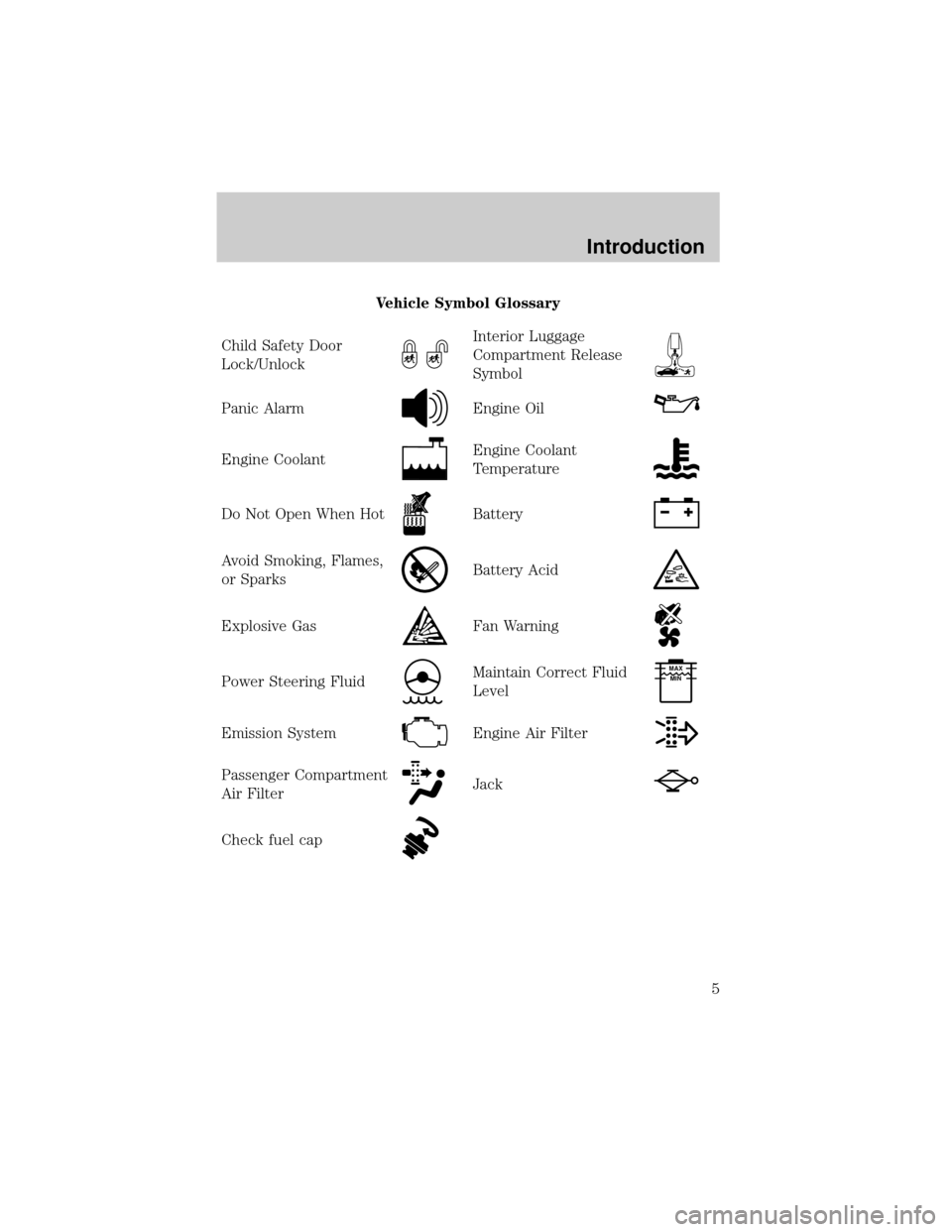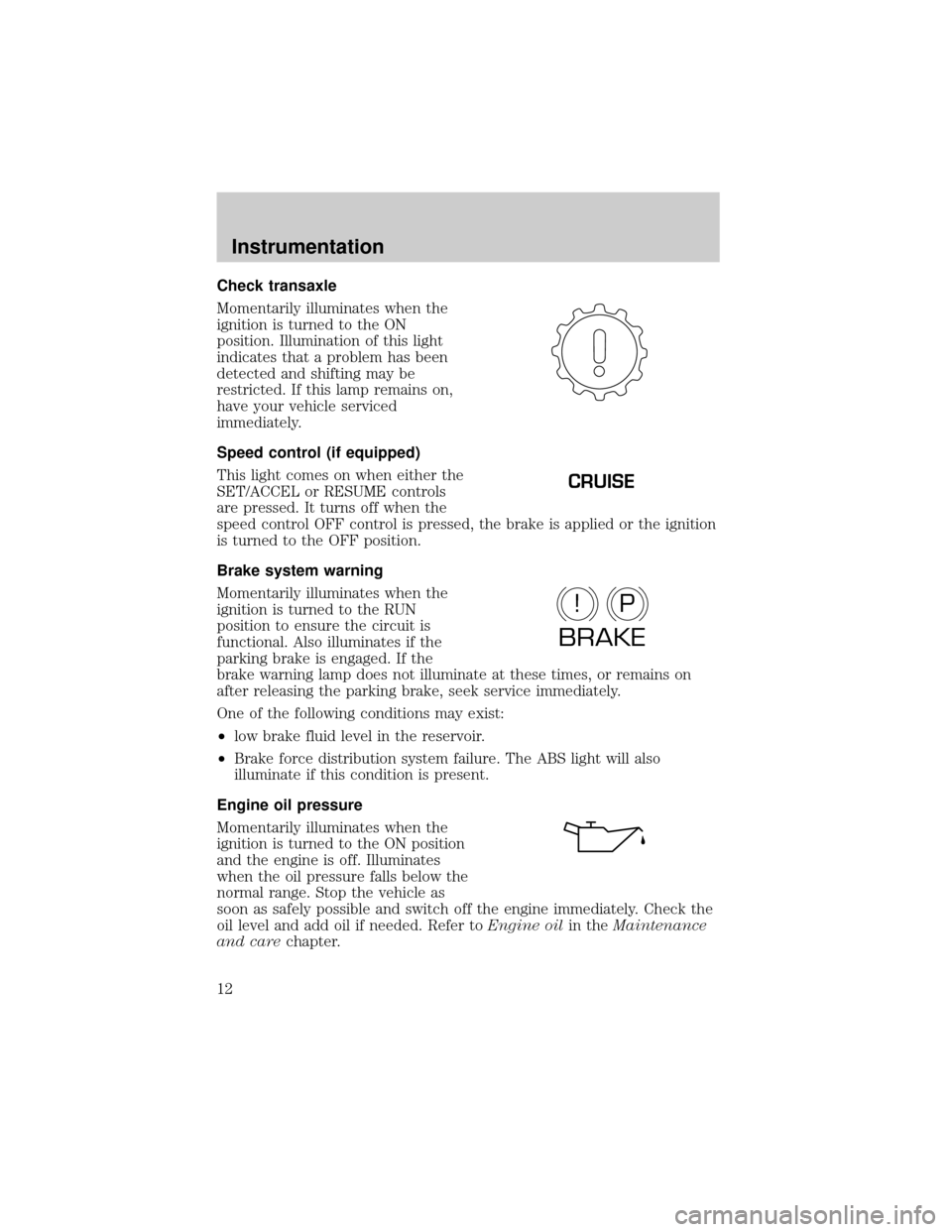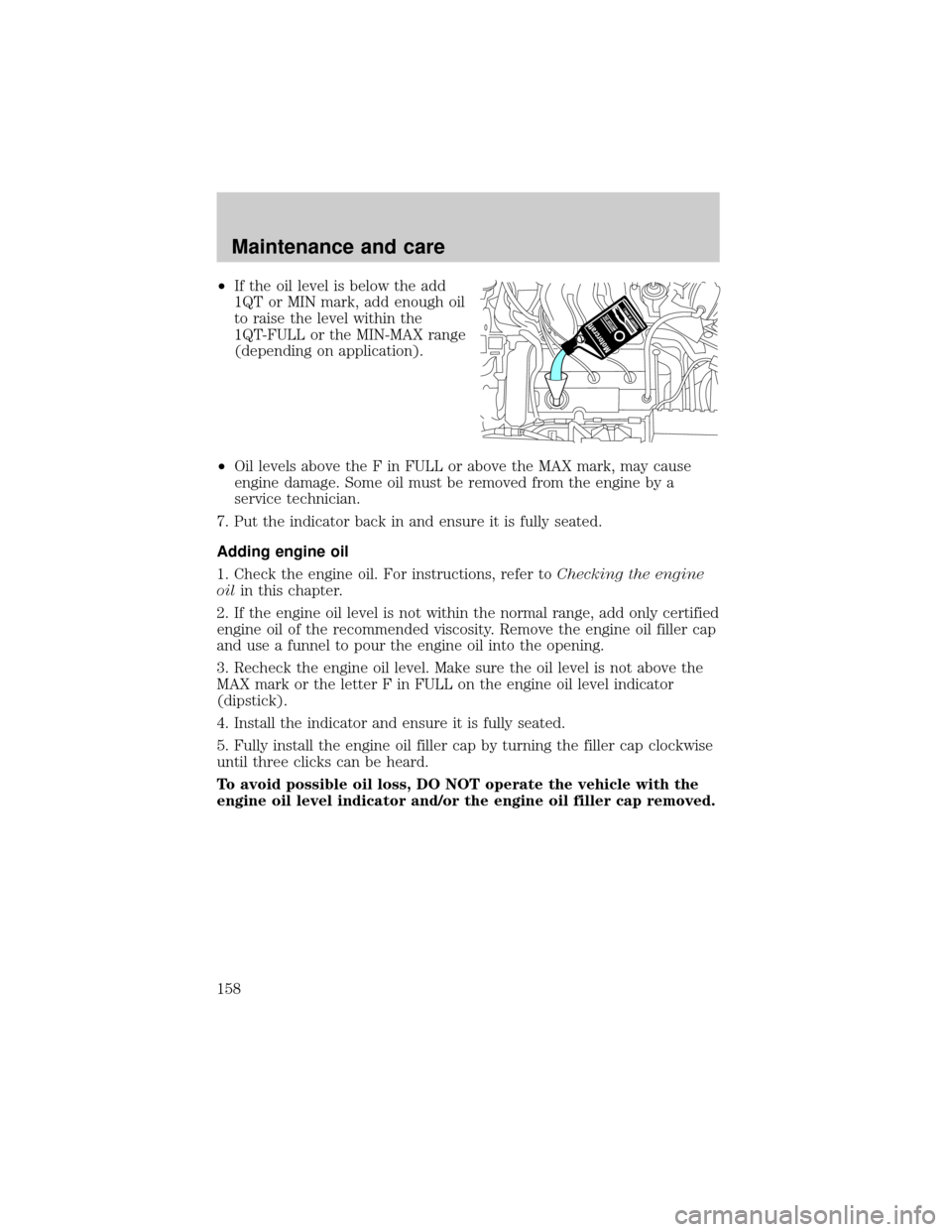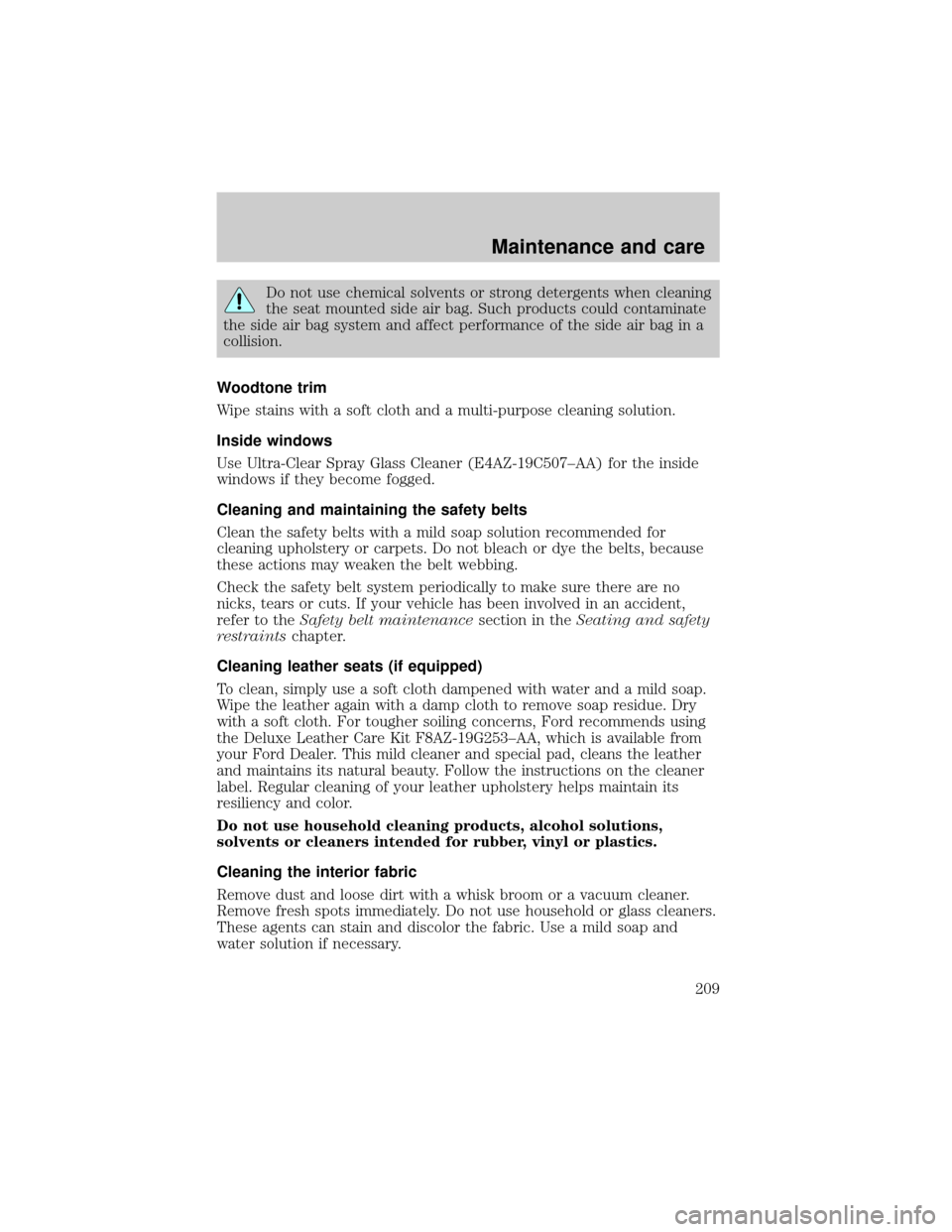check oil Mercury Sable 2001 Owner's Manuals
[x] Cancel search | Manufacturer: MERCURY, Model Year: 2001, Model line: Sable, Model: Mercury Sable 2001Pages: 240, PDF Size: 2.22 MB
Page 5 of 240

Vehicle Symbol Glossary
Child Safety Door
Lock/Unlock
Interior Luggage
Compartment Release
Symbol
Panic AlarmEngine Oil
Engine CoolantEngine Coolant
Temperature
Do Not Open When HotBattery
Avoid Smoking, Flames,
or SparksBattery Acid
Explosive GasFan Warning
Power Steering FluidMaintain Correct Fluid
LevelMAX
MIN
Emission SystemEngine Air Filter
Passenger Compartment
Air FilterJack
Check fuel cap
Introduction
5
Page 12 of 240

Check transaxle
Momentarily illuminates when the
ignition is turned to the ON
position. Illumination of this light
indicates that a problem has been
detected and shifting may be
restricted. If this lamp remains on,
have your vehicle serviced
immediately.
Speed control (if equipped)
This light comes on when either the
SET/ACCEL or RESUME controls
are pressed. It turns off when the
speed control OFF control is pressed, the brake is applied or the ignition
is turned to the OFF position.
Brake system warning
Momentarily illuminates when the
ignition is turned to the RUN
position to ensure the circuit is
functional. Also illuminates if the
parking brake is engaged. If the
brake warning lamp does not illuminate at these times, or remains on
after releasing the parking brake, seek service immediately.
One of the following conditions may exist:
²low brake fluid level in the reservoir.
²Brake force distribution system failure. The ABS light will also
illuminate if this condition is present.
Engine oil pressure
Momentarily illuminates when the
ignition is turned to the ON position
and the engine is off. Illuminates
when the oil pressure falls below the
normal range. Stop the vehicle as
soon as safely possible and switch off the engine immediately. Check the
oil level and add oil if needed. Refer toEngine oilin theMaintenance
and carechapter.
CRUISE
P!
BRAKE
Instrumentation
12
Page 157 of 240

ENGINE OIL
Checking the engine oil
Refer to the scheduled maintenance guide for the appropriate intervals
for checking the engine oil.
1. Make sure the vehicle is on level ground.
2. Turn the engine off and wait a few minutes for the oil to drain into the
oil pan.
3. Set the parking brake and ensure the gearshift is securely latched in P.
4. Open the hood. Protect yourself from engine heat.
5. Locate and carefully remove the
engine oil indicator (dipstick).
6. Wipe the indicator clean. Insert the indicator fully, then remove it
again.
²If the oil level isbetween the add 1QT and FULL marks or
between the MIN and MAX marks (depending on application),
the oil level is acceptable.DO NOT ADD OIL.
MAX MIN
FULL 1QT
Maintenance and care
157
Page 158 of 240

²If the oil level is below the add
1QT or MIN mark, add enough oil
to raise the level within the
1QT-FULL or the MIN-MAX range
(depending on application).
²Oil levels above the F in FULL or above the MAX mark, may cause
engine damage. Some oil must be removed from the engine by a
service technician.
7. Put the indicator back in and ensure it is fully seated.
Adding engine oil
1. Check the engine oil. For instructions, refer toChecking the engine
oilin this chapter.
2. If the engine oil level is not within the normal range, add only certified
engine oil of the recommended viscosity. Remove the engine oil filler cap
and use a funnel to pour the engine oil into the opening.
3. Recheck the engine oil level. Make sure the oil level is not above the
MAX mark or the letter F in FULL on the engine oil level indicator
(dipstick).
4. Install the indicator and ensure it is fully seated.
5. Fully install the engine oil filler cap by turning the filler cap clockwise
until three clicks can be heard.
To avoid possible oil loss, DO NOT operate the vehicle with the
engine oil level indicator and/or the engine oil filler cap removed.
Maintenance and care
158
Page 162 of 240

Checking and adding washer fluid for the liftgate (if equipped)
The opening for the reservoir is
located on the passenger side under
the tail lamp. Refill this reservoir
with the same fluid you use for your
windshield.
ENGINE COOLANT
Checking engine coolant
Your vehicle was factory-filled with a 50/50 engine coolant and water
concentration. If the concentration of coolant falls below 40% or above
60%, the engine parts could become damaged or not work properly.A
50/50 mixture of coolant and water provides the following:
²freeze protection down to -36É C (-34É F).
²boiling protection up to 129É C (265É F).
²protection against rust and other forms of corrosion.
²enables calibrated gages to function properly.
Maintenance and care
162
Page 189 of 240
![Mercury Sable 2001 Owners Manuals ²Sudden or hard accelerations may reduce fuel economy.
²Slow down gradually.
²Driving at reasonable speeds (traveling at 88 km/h [55 mph] uses 15%
less fuel than traveling at 105 km/h [65 mph]).
² Mercury Sable 2001 Owners Manuals ²Sudden or hard accelerations may reduce fuel economy.
²Slow down gradually.
²Driving at reasonable speeds (traveling at 88 km/h [55 mph] uses 15%
less fuel than traveling at 105 km/h [65 mph]).
²](/img/33/11160/w960_11160-188.png)
²Sudden or hard accelerations may reduce fuel economy.
²Slow down gradually.
²Driving at reasonable speeds (traveling at 88 km/h [55 mph] uses 15%
less fuel than traveling at 105 km/h [65 mph]).
²Revving the engine before turning it off may reduce fuel economy.
²Using the air conditioner or defroster may reduce fuel economy.
²You may want to turn off the speed control in hilly terrain if
unnecessary shifting between third and fourth gear occurs.
Unnecessary shifting of this type could result in reduced fuel
economy.
²Warming up a vehicle on cold mornings is not required and may
reduce fuel economy.
²Resting your foot on the brake pedal while driving may reduce fuel
economy.
²Combine errands and minimize stop-and-go driving.
Maintenance
²Keep tires properly inflated and use only recommended size.
²Operating a vehicle with the wheels out of alignment will reduce fuel
economy.
²Use recommended engine oil. Refer toLubricant Specifications.
²Perform all regularly scheduled maintenance items. Follow the
recommended maintenance schedule and owner maintenance checks
found in your vehicle scheduled maintenance guide.
Conditions
²Heavily loading a vehicle or towing a trailer may reduce fuel economy
at any speed.
²Carrying unnecessary weight may reduce fuel economy (approximately
0.4 km/L [1 mpg] is lost for every 180 kg [400 lb] of weight carried).
²Adding certain accessories to your vehicle (for example bug
deflectors, rollbars/light bars, running boards, ski/luggage racks) may
reduce fuel economy.
²Using fuel blended with alcohol may lower fuel economy.
²Fuel economy may decrease with lower temperatures during the first
12±16 km (8±10 miles) of driving.
Maintenance and care
189
Page 209 of 240

Do not use chemical solvents or strong detergents when cleaning
the seat mounted side air bag. Such products could contaminate
the side air bag system and affect performance of the side air bag in a
collision.
Woodtone trim
Wipe stains with a soft cloth and a multi-purpose cleaning solution.
Inside windows
Use Ultra-Clear Spray Glass Cleaner (E4AZ-19C507±AA) for the inside
windows if they become fogged.
Cleaning and maintaining the safety belts
Clean the safety belts with a mild soap solution recommended for
cleaning upholstery or carpets. Do not bleach or dye the belts, because
these actions may weaken the belt webbing.
Check the safety belt system periodically to make sure there are no
nicks, tears or cuts. If your vehicle has been involved in an accident,
refer to theSafety belt maintenancesection in theSeating and safety
restraintschapter.
Cleaning leather seats (if equipped)
To clean, simply use a soft cloth dampened with water and a mild soap.
Wipe the leather again with a damp cloth to remove soap residue. Dry
with a soft cloth. For tougher soiling concerns, Ford recommends using
the Deluxe Leather Care Kit F8AZ-19G253±AA, which is available from
your Ford Dealer. This mild cleaner and special pad, cleans the leather
and maintains its natural beauty. Follow the instructions on the cleaner
label. Regular cleaning of your leather upholstery helps maintain its
resiliency and color.
Do not use household cleaning products, alcohol solutions,
solvents or cleaners intended for rubber, vinyl or plastics.
Cleaning the interior fabric
Remove dust and loose dirt with a whisk broom or a vacuum cleaner.
Remove fresh spots immediately. Do not use household or glass cleaners.
These agents can stain and discolor the fabric. Use a mild soap and
water solution if necessary.
Maintenance and care
209
Page 232 of 240

Child safety seats ......................105
attaching with tether straps ..109
in front seat ............................106
in rear seat ......................106, 109
LATCH .....................................111
Cleaning your vehicle ...............204
engine compartment ..............207
exterior ....................................205
exterior lamps .........................206
instrument cluster lens ..........208
instrument panel ....................208
interior .............................208±209
mirrors .....................................206
plastic parts ............................206
safety belts ..............................209
washing ....................................204
waxing .....................................205
wheels ......................................206
windows ..................................209
wiper blades ............................206
woodtone trim ........................209
Climate control (see Air
conditioning or Heating) ............19
Clock ......................................35, 41
Console ........................................59
Controls
power seat .................................78
Coolant
checking and adding ..............162
refill capacities ................165, 211
specifications ..................212±213
Cruise control
(see Speed control) ....................47
Customer Assistance ................135
Ford accessories
for your vehicle ......................225
Ford Extended
Service Plan ............................217Getting assistance outside
the U.S. and Canada ..............224
Getting roadside assistance ...135
Getting the
service you need ....................217
Ordering additional
owner's literature ...................228
The Dispute
Settlement Board ...................220
Utilizing the Mediation/
Arbitration Program ...............223
D
Daytime running lamps
(see Lamps) ................................17
Defrost
rear window ..............................19
Dipstick
automatic
transmission fluid ...................168
engine oil .................................157
Doors
door ajar warning .......................9
lubricant specifications ..........212
Driving under special
conditions
through water .........................129
E
Emergencies, roadside
jump-starting ..........................147
Emission control system ..........190
Engine ........................................213
check engine/
service engine soon light ...........9
cleaning ...................................207
coolant .....................................162
Index
232
Page 233 of 240

idle speed control ...................175
lubrication
specifications ..................212±213
refill capacities ........................211
service points ..................155±156
starting after a collision .........136
Engine block heater .................116
Engine oil ..................................157
checking and adding ..............157
dipstick ....................................157
filter, specifications ........159, 210
recommendations ...................159
refill capacities ........................211
specifications ..................212±213
Exhaust fumes ..........................116
F
Floor mats ...................................59
Fluid capacities .........................211
Foglamps .....................................18
Fuel ............................................182
calculating fuel economy .......187
cap .......................................9, 184
capacity ...................................211
choosing the right fuel ...........185
comparisons with EPA fuel
economy estimates .................190
detergent in fuel .....................186
filling your vehicle
with fuel ..................182, 184, 187
filter, specifications ........186, 210
fuel pump shut-off switch .....136
gauge .........................................16
improving fuel economy ........187
low fuel warning light ..............11
octane rating ...................185, 213
quality ......................................185
running out of fuel .................186safety information relating to
automotive fuels .....................182
Fuses ..................................138±139
G
Gas cap (see Fuel cap) ........9, 184
Gas mileage
(see Fuel economy) .................187
Gauges .........................................14
engine coolant
temperature gauge ...................15
fuel gauge ..................................16
odometer ...................................15
speedometer .............................14
tachometer ................................14
trip odometer ............................15
GAWR
(Gross Axle Weight Rating) .....128
definition .................................128
driving with a heavy load ......128
location ....................................128
GVWR (Gross
Vehicle Weight Rating) .............128
calculating ...............................128
definition .................................128
driving with a heavy load ......128
location ....................................128
H
Hazard flashers .........................136
Head restraints ...........................77
Headlamps ...................................17
aiming ..............................202±203
autolamp system .......................18
bulb specifications ..................201
daytime running lights .............17
flash to pass ..............................17
Index
233
Page 234 of 240

high beam .............................8, 17
replacing bulbs .......................193
turning on and off ....................17
warning chime ..........................13
Heating ........................................19
heating and
air conditioning system ............19
Hood ..........................................154
I
Ignition .................................47, 213
Infant seats
(see Safety seats) .....................105
Inspection/maintenance
(I/M) testing ..............................191
Instrument panel
cleaning ...................................208
cluster ..................................8, 208
lighting up
panel and interior .....................18
location of components ..............8
J
Jack ............................................143
positioning ...............................143
storage .....................................143
Jump-starting your vehicle ......147
K
Keyless entry system .................69
autolock .....................................71
keypad .......................................69
locking and unlocking doors ....71
programming entry code .........70
Keys .......................................73, 75
key in ignition chime ...............13positions of the ignition ...........47
L
Lamps
autolamp system .......................18
bulb replacement
specifications chart ................201
cargo lamps ...............................18
daytime running light ...............17
fog lamps ...................................18
headlamps .................................17
headlamps, flash to pass ..........17
instrument panel, dimming .....18
interior lamps .............52±53, 201
replacing
bulbs ........192±193, 195±197, 200
Lane change indicator
(see Turn signal) ........................50
Liftgate ..................................60, 64
Lights, warning and indicator ......8
air bag ........................................13
anti-lock brakes (ABS) ....11, 119
anti-theft ...................................11
brake ..........................................12
charging system ........................13
check coolant ............................12
cruise indicator .........................12
door ajar ......................................9
fuel cap light ...............................9
high beam ...................................8
low coolant ................................11
low fuel ......................................11
oil pressure ...............................12
safety belt ...................................9
service engine soon ....................9
speed control ............................50
traction control active ................8
turn signal indicator ...................8
Load limits .................................128
Index
234